Legacy of Human Impact on Geomorphic Processes in Mountain Headwater Streams in the Perspective of European Cultural Landscapes
Abstract
:1. Introduction
2. Materials and Methods
2.1. Study Area
2.2. Data Sources
3. Overview of Human Impact on Geomorphic Processes of Mountain Headwater Streams
3.1. Land Cover Changes
3.2. Timber Floating
3.3. Torrent Control Works
3.4. The Complex Evolutionary Trajectory of Mountain Headwater Streams
3.5. Implications for of Hydromorphological Assessment and Restoration of Mountain Headwater Streams
- Restoration of downstream sediment connectivity as much as possible by removal of longitudinal barriers (check dams, unfitted culverts) or artificial embankments, but with careful evaluation of possible flood risk in the inhabited valleys and alluvial cones;
- protection of riparian tree buffers and thus, improvement of the potential for instream wood recruitment and its consequent geomorphic function in the channels;
4. Conclusions
Funding
Institutional Review Board Statement
Informed Consent Statement
Data Availability Statement
Acknowledgments
Conflicts of Interest
References
- Tieskens, K.; Schulp, C.J.; Levers, C.; Lieskovský, J.; Kuemmerle, T.; Plieninger, T.; Verburg, P. Characterizing European cultural landscapes: Accounting for structure, management intensity and value of agricultural and forest landscapes. Land Use Policy 2017, 62, 29–39. [Google Scholar] [CrossRef] [Green Version]
- Gurnell, A.; Surian, N.; Zanoni, L. Multi-thread river channels: A perspective on changing European alpine river systems. Aquat. Sci. 2009, 71, 253–265. [Google Scholar] [CrossRef]
- Ollero, A. Channel changes and floodplain management in the meandering middle Ebro River, Spain. Geomorphology 2010, 117, 247–260. [Google Scholar] [CrossRef]
- Hajdukiewicz, H.; Wyżga, B.; Zawiejska, J. Twentieth-century hydromorphological degradation of Polish Carpathian rivers. Quat. Int. 2019, 504, 181–194. [Google Scholar] [CrossRef]
- Kiss, T.; Blanka, V. River channel response to climate- and human-induced hydrological changes: Case study on the meandering Hernád River, Hungary. Geomorphology 2012, 175, 115–125. [Google Scholar] [CrossRef]
- Belletti, B.; Rinaldi, M.; Buijse, A.D.; Gurnell, A.M.; Mosselman, E. A review of assessment methods for river hydromorphology. Environ. Earth Sci. 2014, 73, 2079–2100. [Google Scholar] [CrossRef]
- Rinaldi, M.; Surian, N.; Comiti, F.; Bussettini, M. A methodological framework for hydromorphological assessment, analysis and monitoring (IDRAIM) aimed at promoting integrated river management. Geomorphology 2015, 251, 122–136. [Google Scholar] [CrossRef]
- Muhar, S.; Januschke, K.; Kail, J.; Poppe, M.; Schmutz, S.; Hering, D.; Buijse, A.D. Evaluating good-practice cases for river restoration across Europe: Context, methodological framework, selected results and recommendations. Hydrobiologia 2016, 769, 3–19. [Google Scholar] [CrossRef] [Green Version]
- Benda, L.; Hassan, M.A.; Church, M.; May, C.L. Geomorphology of Steepland Headwaters: The Transition from Hillslopes to Channels. JAWRA J. Am. Water Resour. Assoc. 2005, 41, 835–851. [Google Scholar] [CrossRef]
- Wipfli, M.S.; Richardson, J.; Naiman, R.J. Ecological Linkages Between Headwaters and Downstream Ecosystems: Transport of Organic Matter, Invertebrates, and Wood Down Headwater Channels. JAWRA J. Am. Water Resour. Assoc. 2007, 43, 72–85. [Google Scholar] [CrossRef]
- Wohl, E. The significance of small streams. Front. Earth Sci. 2017, 11, 447–456. [Google Scholar] [CrossRef]
- Wohl, E. Human impacts to mountain streams. Geomorphology 2006, 79, 217–248. [Google Scholar] [CrossRef] [Green Version]
- Kasai, M. Channel processes following land use changes in a degrading steep headwater stream in North Island, New Zealand. Geomorphology 2006, 81, 421–439. [Google Scholar] [CrossRef]
- Kondolf, G.M. PROFILE: Hungry Water: Effects of Dams and Gravel Mining on River Channels. Environ. Manag. 1997, 21, 533–551. [Google Scholar] [CrossRef] [PubMed]
- Liro, M.; Ruiz-Villanueva, V.; Mikuś, P.; Wyżga, B.; Castellet, E.B. Changes in the hydrodynamics of a mountain river induced by dam reservoir backwater. Sci. Total Environ. 2020, 744, 140555. [Google Scholar] [CrossRef] [PubMed]
- Piton, G.; Carladous, S.; Recking, A.; Tacnet, J.M.; Liébault, F.; Kuss, D.; Quefféléan, Y.; Marco, O. Why do we build check dams in Alpine streams? An historical perspective from the French experience. Earth Surf. Process. Landf. 2016, 42, 91–108. [Google Scholar] [CrossRef]
- Bombino, G.; Gurnell, A.; Tamburino, V.; Zema, D.; Zimbone, S.M. Sediment size variation in torrents with check dams: Effects on riparian vegetation. Ecol. Eng. 2008, 32, 166–177. [Google Scholar] [CrossRef]
- Korpak, J. Assessment of Changes in Channel Morphology in a Mountain River Regulated Using Grade Control Structures. J. Ecol. Eng. 2020, 21, 163–176. [Google Scholar] [CrossRef]
- Fortugno, D.; Boix-Fayos, C.; Bombino, G.; Denisi, P.; Rubio, J.M.Q.; Tamburino, V.; Zema, D.A. Adjustments in channel morphology due to land-use changes and check dam installation in mountain torrents of Calabria (southern Italy). Earth Surf. Process. Landf. 2017, 42, 2469–2483. [Google Scholar] [CrossRef]
- Tolasz, R.; Miková, T.; Valeriánová, A.; Voženílek, V. Climate Atlas of Czechia; Czech Hydrometeorological Institute and Palacký University in Olomouc: Olomouc, Czechia, 2007. [Google Scholar]
- Šilhán, K. Frequency, predisposition, and triggers of floods in flysch Carpathians: Regional study using dendrogeomorphic methods. Geomorphology 2015, 234, 243–253. [Google Scholar] [CrossRef]
- Bíba, M.; Oceánská, Z.; Vícha, Z.; Jařabáč, M. Lesnicko-hydrologický výzkum v Beskydských experimentálních povodích. J. Hydrol. Hydromech. 2006, 54, 113–122. [Google Scholar]
- Břežný, M.; Pánek, T. Deep-seated landslides affecting monoclinal flysch morphostructure: Evaluation of LiDAR-derived topography of the highest range of the Czech Carpathians. Geomorphology 2017, 285, 44–57. [Google Scholar] [CrossRef]
- Šilhán, K.; Tichavský, R.; Fabiánová, A.; Chalupa, V.; Chalupová, O.; Škarpich, V.; Tolasz, R. Understanding complex slope deformation through tree-ring analyses. Sci. Total Environ. 2019, 665, 1083–1094. [Google Scholar] [CrossRef]
- Galia, T.; Škarpich, V. Do the coarsest bed fractions and stream power record contemporary trends in steep headwater channels? Geomorphology 2016, 272, 115–126. [Google Scholar] [CrossRef]
- Galia, T.; Škarpich, V.; Hradecký, J. Connectivity of the coarsest fraction in headwater channels: Imprints of fluvial processes and debris-flow activity. Geogr. Ann. Ser. A Phys. Geogr. 2015, 97, 437–452. [Google Scholar] [CrossRef]
- Wyżga, B.; Zawiejska, J.; Hajdukiewicz, H. Multi-thread rivers in the Polish Carpathians: Occurrence, decline and possibilities of restoration. Quat. Int. 2016, 415, 344–356. [Google Scholar] [CrossRef]
- Kidová, A.; Radecki-Pawlik, A.; Rusnák, M.; Plesiński, K. Hydromorphological evaluation of the river training impact on a multi-thread river system (Belá River, Carpathians, Slovakia). Sci. Rep. 2021, 11, 1–18. [Google Scholar] [CrossRef] [PubMed]
- Škarpich, V.; Galia, T.; Hradecký, J. Channel Bed Adjustment to Over Bankfull Discharge Magnitudes of the Flysch Gravel-Bed Stream—Case Study from the Channelized Reach of the Olše River (Czech Republic). Z. Geomorphol. 2016, 60, 327–341. [Google Scholar] [CrossRef]
- Škarpich, V.; Kašpárek, Z.; Galia, T.; Hradecký, J. Antropogenní impakt a jeho odezva v morfologii koryt beskydských štěrkonosných toků: Příkladová studie řeky Ostravice, Česko. Geografie 2016, 121, 99–120. [Google Scholar] [CrossRef] [Green Version]
- Polášek, J. Tradice Výroby a Zpracování železa v Beskydech a Pobeskydí: Plavení Dřeva a Zaniklé výrobní Objekty v Oblasti Moravskoslezských a Slezských Beskyd; Muzeum Beskyd: Frýdek-Místek, Czech Republic, 2006. [Google Scholar]
- Škarpich, V.; Hradecký, J.; Tábořík, P. Structure and genesis of the quaternary filling of the Slavíč River valley (Moravskoslezské Beskydy Mts., Czech Republic). Morav. Geogr. Rep. 2011, 19, 30–38. [Google Scholar]
- Nature Conservation Agency of the Czech Republic. Available online: https://beskydy.ochranaprirody.cz/ (accessed on 15 May 2021).
- Brierley, G.J.; Fryirs, K.A. The Use of Evolutionary Trajectories to Guide ‘Moving Targets’ in the Management of River Futures. River Res. Appl. 2015, 32, 823–835. [Google Scholar] [CrossRef]
- Tlapáková, L.; Pánek, T.; Horáčková, Š. Holocene fluvial terraces reveal landscape changes in the headwater streams of the Moravskoslezské Beskydy Mountains, Czechia. Geomorphology 2021, 377, 107589. [Google Scholar] [CrossRef]
- Wistuba, M.; Sady, A.; Poręba, G. The impact of Wallachian settlement on relief and alluvia composition in small valleys of the Carpathian Mts. (Czech Republic). Catena 2018, 160, 10–23. [Google Scholar] [CrossRef]
- Galia, T.; Škarpich, V. Morfologická odezva bystřinných koryt na dlouhodobé zásahy člověka v horských povodích na příkladu Moravskoslezských Beskyd (Česko). Geogr. CGS 2017, 122, 213–235. [Google Scholar]
- Voznicová, T. Changes in the Land Use in the Cadastral Territory of Morávka; University of Ostrava: Ostrava, Czech, 2008. [Google Scholar]
- Galia, T.; Škarpich, V.; Ruman, S.; Macurová, T. Check dams decrease the channel complexity of intermediate reaches in the Western Carpathians (Czech Republic). Sci. Total Environ. 2019, 662, 881–894. [Google Scholar] [CrossRef] [PubMed]
- Galia, T. Controls on log step occurrence in steep headwater streams draining Carpathian managed forests. Ecol. Eng. 2018, 120, 384–396. [Google Scholar] [CrossRef]
- Galia, T.; Ruiz-Villanueva, V.; Tichavský, R.; Šilhán, K.; Horacek, M.; Stoffel, M. Characteristics and abundance of large and small instream wood in a Carpathian mixed-forest headwater basin. For. Ecol. Manag. 2018, 424, 468–482. [Google Scholar] [CrossRef]
- Galia, T.; Šilhán, K.; Ruiz-Villanueva, V.; Tichavský, R.; Stoffel, M. Temporal dynamics of instream wood in headwater streams draining mixed Carpathian forests. Geomorphology 2017, 292, 35–46. [Google Scholar] [CrossRef]
- Album Valašska; Odbor Klubu Českých Turistů: Štramberk, Czech Republic, 1898.
- Jařabáč, M.; Bělský, J. The protection against floods becomes effective in the Beskydy Mts. using forest hydrology. Časopis Beskydy 2008, 1, 37–42. [Google Scholar]
- Galia, T.; Škarpich, V. Response of Bed Sediments on the Grade-Control Structure Management of a Small Piedmont Stream. River Res. Appl. 2016, 33, 483–494. [Google Scholar] [CrossRef]
- Marchi, L.; Comiti, F.; Crema, S.; Cavalli, M. Channel control works and sediment connectivity in the European Alps. Sci. Total Environ. 2019, 668, 389–399. [Google Scholar] [CrossRef]
- Galia, T.; Škarpich, V.; Ruman, S. Impact of check dam series on coarse sediment connectivity. Geomorphology 2021, 377, 107595. [Google Scholar] [CrossRef]
- Zema, D.A.; Bombino, G.; Denisi, P.; Lucas-Borja, M.E.; Zimbone, S.M. Evaluating the effects of check dams on channel geometry, bed sediment size and riparian vegetation in Mediterranean mountain torrents. Sci. Total Environ. 2018, 642, 327–340. [Google Scholar] [CrossRef]
- Galia, T.; Šilhán, K.; Škarpich, V. The geomorphic impacts of culverts at paved forest roads: Examples from Carpathian headwater channels, Czech Republic. Catena 2017, 157, 424–435. [Google Scholar] [CrossRef]
- Galia, T.; Hradecký, J.; Škarpich, V. Sediment Transport in Headwater Streams of the Carpathian Flysch Belt: Its Nature and Recent Effects of Human Interventions. In Sediment Matters; Springer: Berlin/Heidelberg, Germany, 2015; pp. 13–26. ISBN 9783319146966. [Google Scholar]
- Buzek, L. Plaveninový režim jako ukazatel intenzity vodní eroze v horských zalesněných povodích (na příkladu Moravskoslezských Beskyd). J. Hydrol. Hydromech. 2004, 52, 24–40. [Google Scholar]
- Blöschl, G.; Hall, J.; Viglione, A.; Perdigão, R.A.P.; Parajka, J.; Merz, B.; Lun, D.; Arheimer, B.; Aronica, G.T.; Bilibashi, A.; et al. Changing climate both increases and decreases European river floods. Nat. Cell Biol. 2019, 573, 108–111. [Google Scholar] [CrossRef]
- Comiti, F. How natural are Alpine mountain rivers? Evidence from the Italian Alps. Earth Surf. Process. Landf. 2011, 37, 693–707. [Google Scholar] [CrossRef]
- Harvey, A. Coupling between hillslopes and channels in upland fluvial systems: Implications for landscape sensitivity, illustrated from the Howgill Fells, northwest England. Catena 2001, 42, 225–250. [Google Scholar] [CrossRef]
- Klimek, K.; Latocha, A. Response of small mid-mountain rivers to human impact with particular reference to the last 200 years; Eastern Sudetes, Central Europe. Geomorphology 2007, 92, 147–165. [Google Scholar] [CrossRef]
- Bucała, A. The impact of human activities on land use and land cover changes and environmental processes in the Gorce Mountains (Western Polish Carpathians) in the past 50 years. J. Environ. Manag. 2014, 138, 4–14. [Google Scholar] [CrossRef]
- Liébault, F.; Gomez, B.; Page, M.; Marden, M.; Peacock, D.; Richard, D.; Trotter, C.M. Land-use change, sediment production and channel response in upland regions. River Res. Appl. 2005, 21, 739–756. [Google Scholar] [CrossRef]
- Preciso, E.; Salemi, E.; Billi, P. Land use changes, torrent control works and sediment mining: Effects on channel morphology and sediment flux, case study of the Reno River (Northern Italy). Hydrol. Process. 2011, 26, 1134–1148. [Google Scholar] [CrossRef]
- Atherden, M.A.; Hall, J.A. Human impact on vegetation in the White Mountains of Crete since AD 500. Holocene 1999, 9, 183–193. [Google Scholar] [CrossRef]
- Bombino, G.; Gurnell, A.M.; Tamburino, V.; Zema, D.A.; Zimbone, S.M. Adjustments in channel form, sediment calibre and vegetation around check-dams in the headwater reaches of mountain torrents, Calabria, Italy. Earth Surf. Process. Landf. 2009, 34, 1011–1021. [Google Scholar] [CrossRef]
- Klimas, K.; Hiesl, P.; Hagan, D.; Park, D. Prescribed fire effects on sediment and nutrient exports in forested environments: A review. J. Environ. Qual. 2020, 49, 793–811. [Google Scholar] [CrossRef] [PubMed]
- Rinaldi, M.; Surian, N.; Comiti, F.; Bussettini, M.; Belletti, B.; Nardi, L.; Lastoria, B.; Golfieri, B. Guidebook for the Evaluation of Stream Morphological Conditions by the Morphological Quality Index (MQI), Deliverable 6.2, Part. 3, of REFORM (REstoring Rivers FOR Effective Catchment Management), a Collaborative Project (Large-Scale Integrating Project) Funded by the European Commission within the 7th Framework Programme under Grant Agreement 282656, European Commission: Brussels, Belgium, 2015.
- Galia, T.; Hradecký, J. Channel-reach morphology controls of headwater streams based in flysch geologic structures: An example from the Outer Western Carpathians, Czech Republic. Geomorphology 2014, 216, 1–12. [Google Scholar] [CrossRef]
- Montgomery, D.R.; Buffington, J.M. Channel-reach morphology in mountain drainage basins. GSA Bull. 1997, 109, 596–611. [Google Scholar] [CrossRef]
- Palucis, M.C.; Lamb, M.P. What controls channel form in steep mountain streams? Geophys. Res. Lett. 2017, 44, 7245–7255. [Google Scholar] [CrossRef]
- Comiti, F.; Mao, L.; Lenzi, M.A.; Siligardi, M. Artificial steps to stabilize mountain rivers: A post-project ecological assessment. River Res. Appl. 2009, 25, 639–659. [Google Scholar] [CrossRef]
- Yu, G.-A.; Wang, Z.-Y.; Zhang, K.; Duan, X.; Chang, T.-C. Restoration of an incised mountain stream using artificial step-pool system. J. Hydraul. Res. 2010, 48, 178–187. [Google Scholar] [CrossRef]
- Lenzi, M.A. Stream bed stabilization using boulder check dams that mimic step-pool morphology features in Northern Italy. Geomorphology 2002, 45, 243–260. [Google Scholar] [CrossRef]
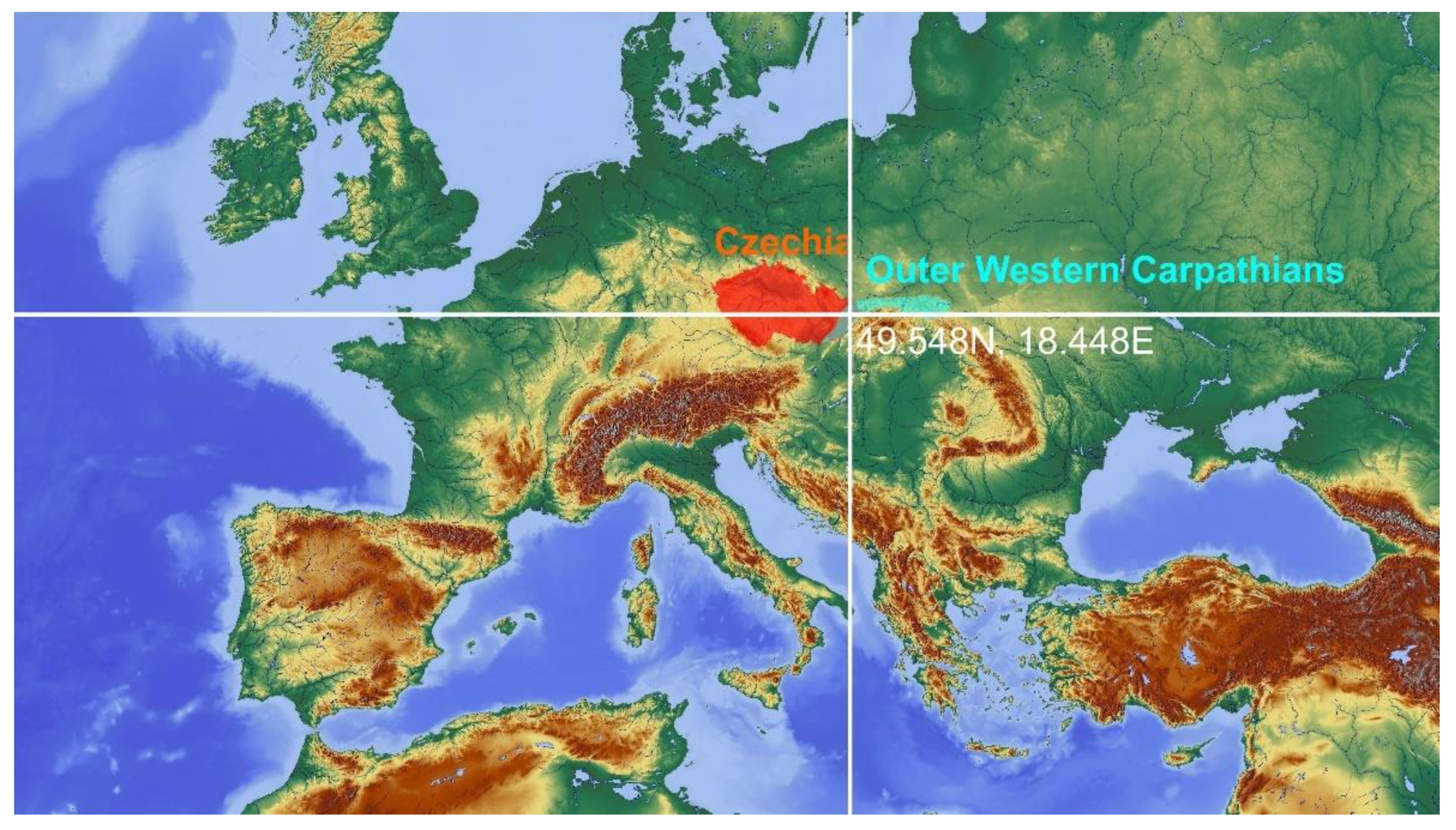
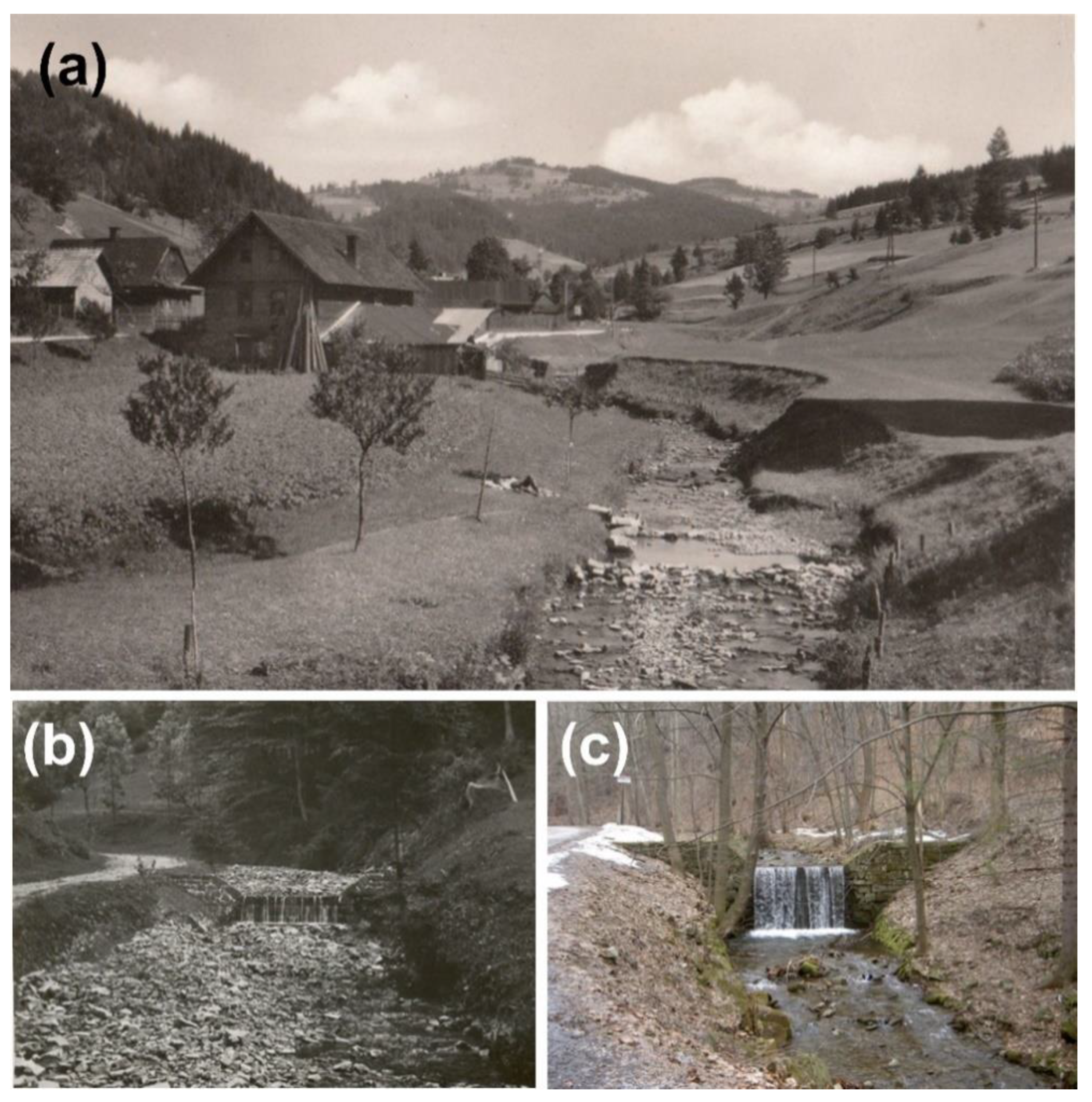
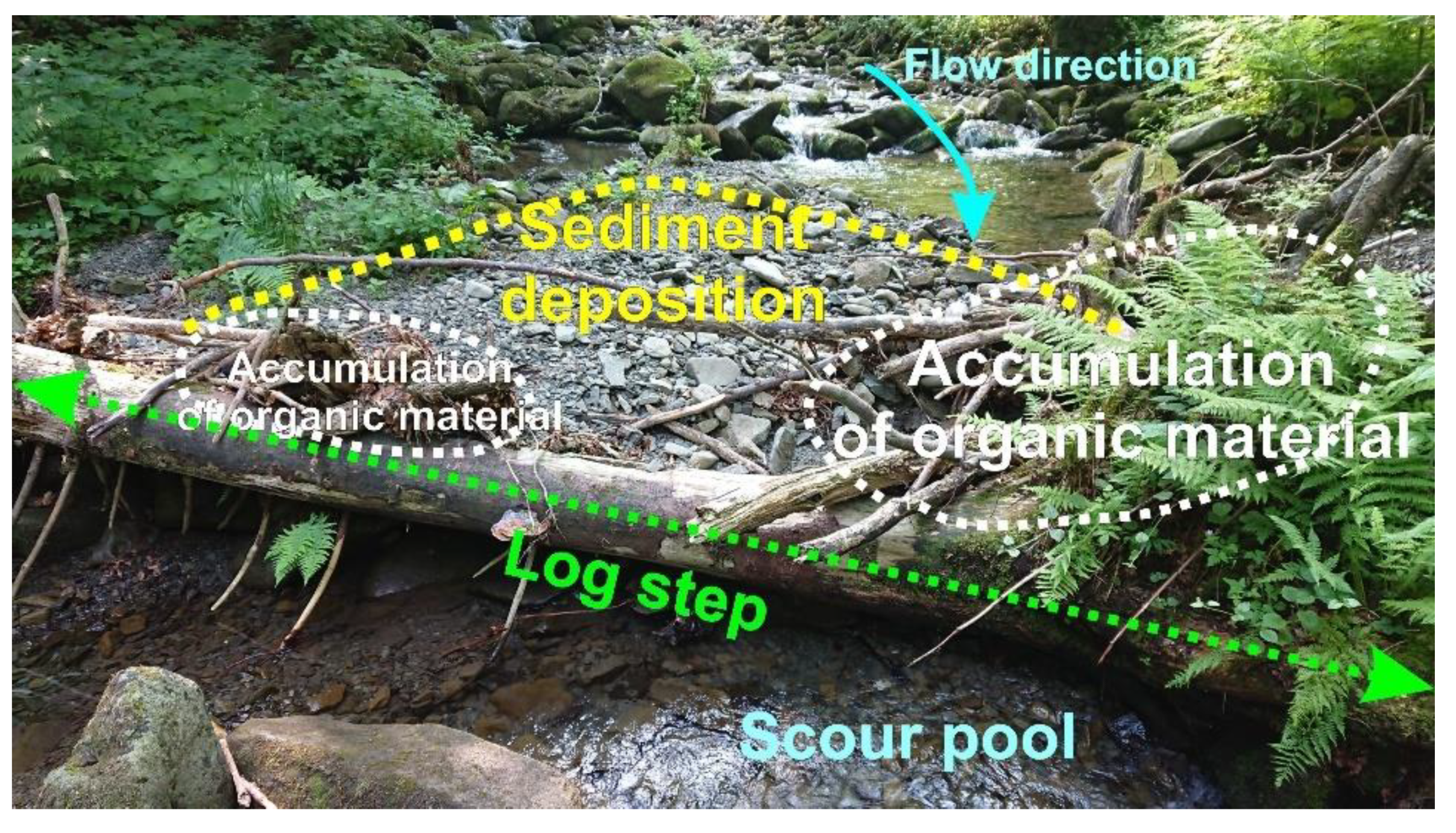
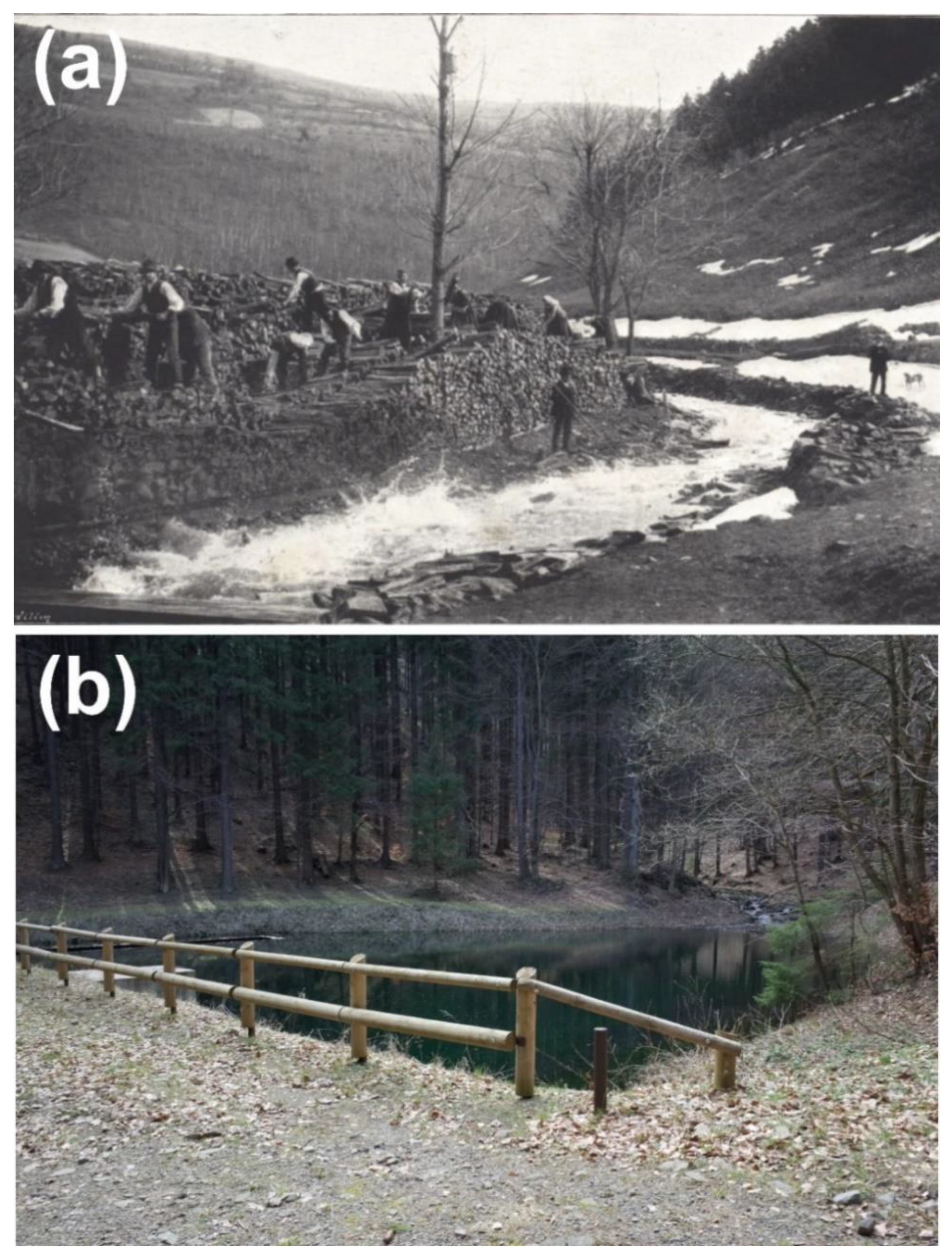

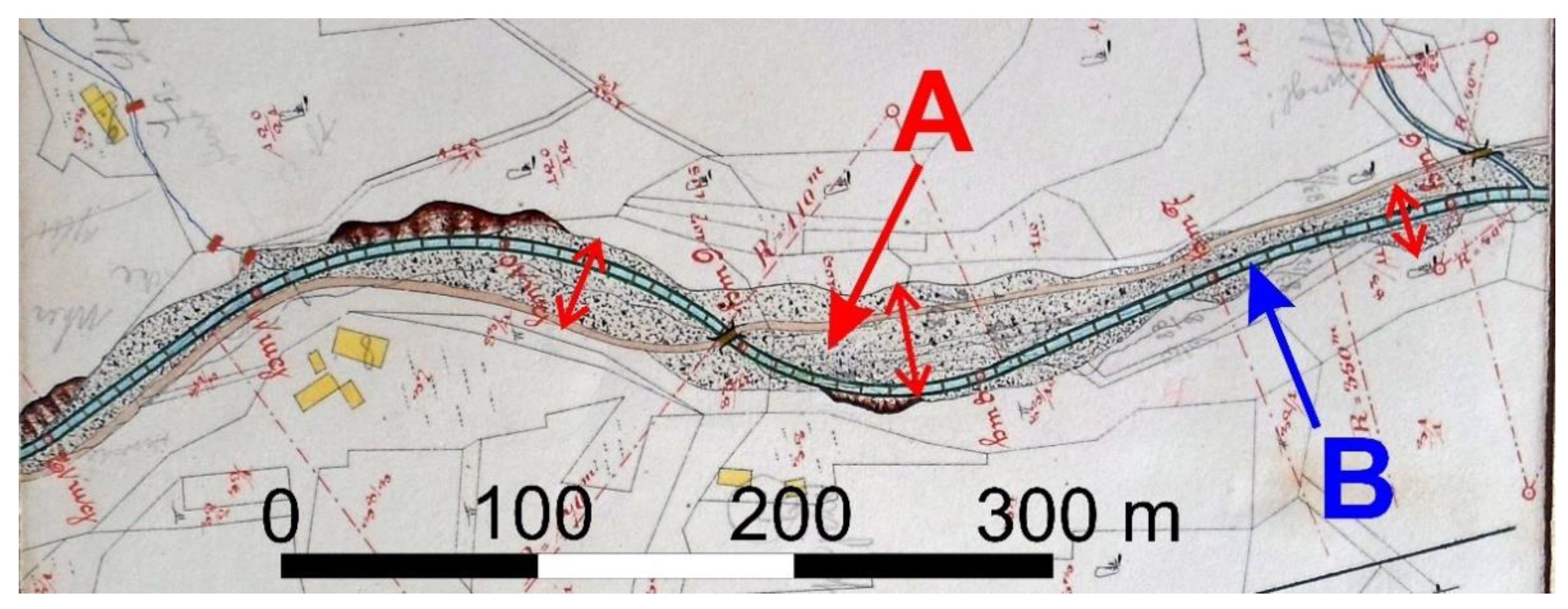

Publisher’s Note: MDPI stays neutral with regard to jurisdictional claims in published maps and institutional affiliations. |
© 2021 by the author. Licensee MDPI, Basel, Switzerland. This article is an open access article distributed under the terms and conditions of the Creative Commons Attribution (CC BY) license (https://creativecommons.org/licenses/by/4.0/).
Share and Cite
Galia, T. Legacy of Human Impact on Geomorphic Processes in Mountain Headwater Streams in the Perspective of European Cultural Landscapes. Geosciences 2021, 11, 253. https://doi.org/10.3390/geosciences11060253
Galia T. Legacy of Human Impact on Geomorphic Processes in Mountain Headwater Streams in the Perspective of European Cultural Landscapes. Geosciences. 2021; 11(6):253. https://doi.org/10.3390/geosciences11060253
Chicago/Turabian StyleGalia, Tomáš. 2021. "Legacy of Human Impact on Geomorphic Processes in Mountain Headwater Streams in the Perspective of European Cultural Landscapes" Geosciences 11, no. 6: 253. https://doi.org/10.3390/geosciences11060253





